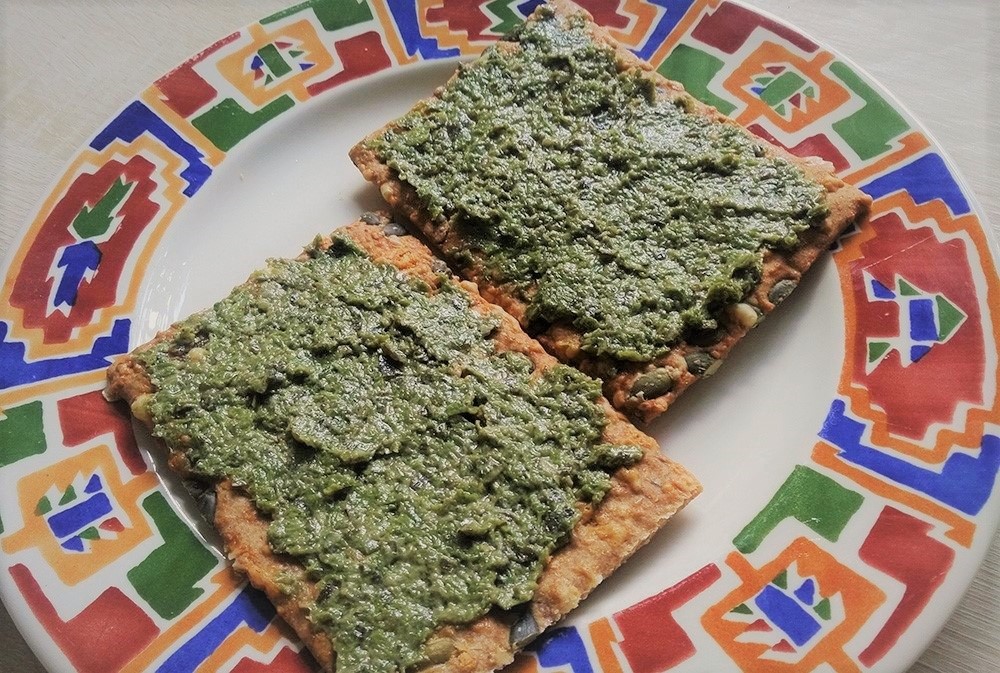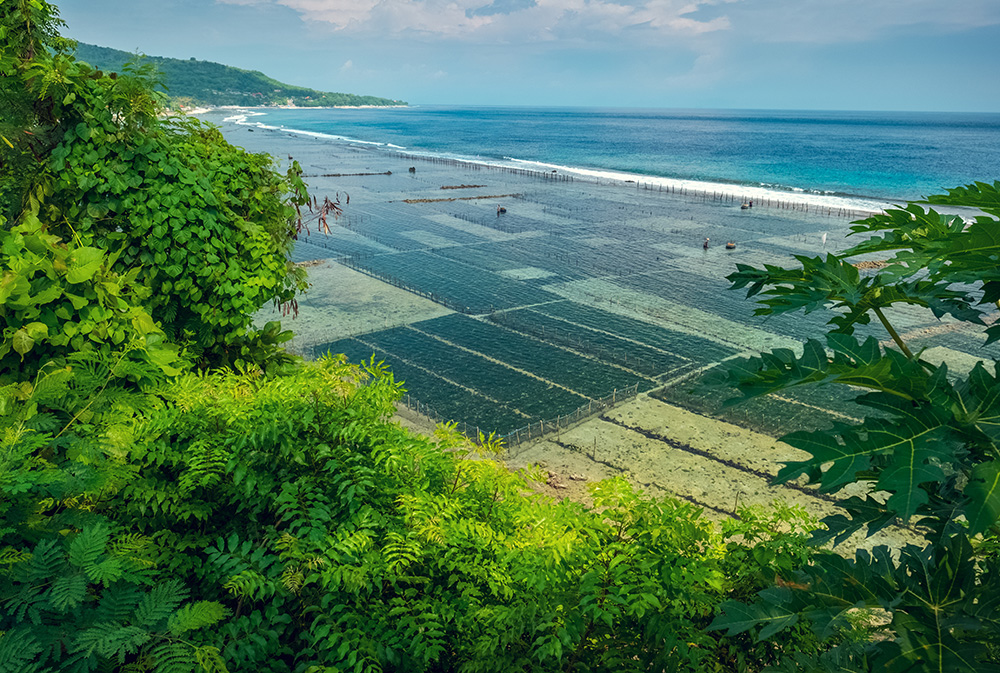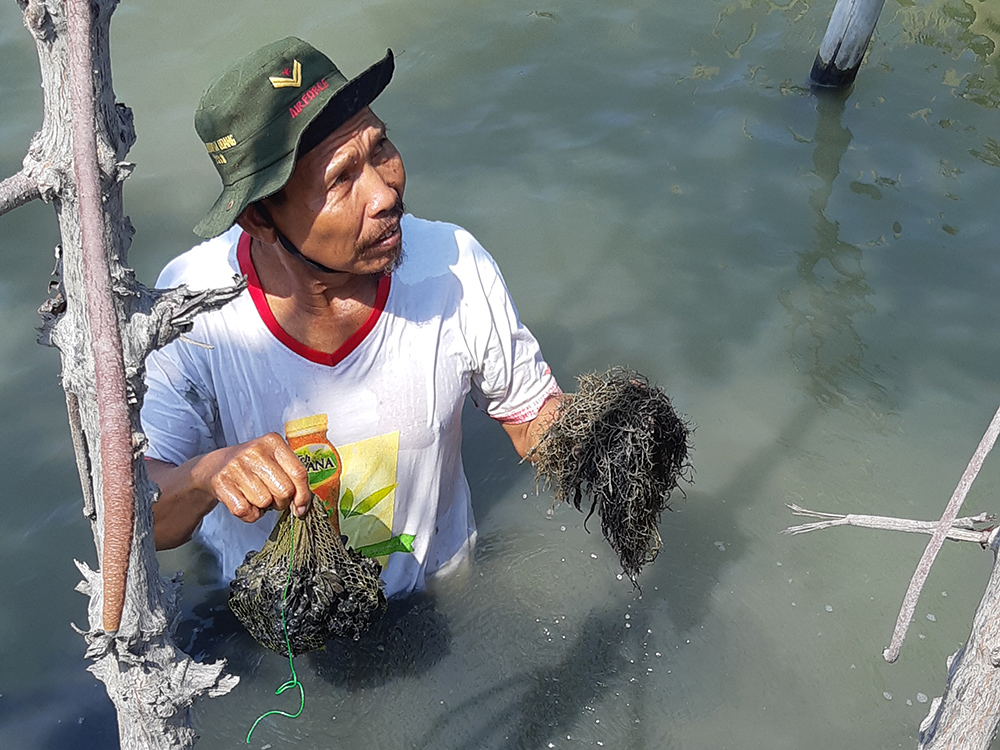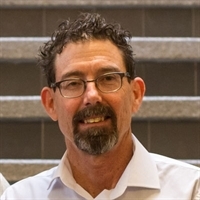Seaweed as a sustainable food source
More food is needed to feed the increasing world population. But the availability of arable land and water is decreasing. This is why Wageningen and Indonesian scientists and businesses, research the possibilities of cultivating seaweed. Cultivating seaweed requires only sunlight, while it purifies water, and is a sustainable crop. Furthermore, seaweed is a ‘superfood’, which is easy to process into healthy and tasty food for human and animal consumption. Do you want a seaweed cracker?
‘Worldwide, there are approximately 48 million square kilometres of sea suitable for the cultivation of seaweed,’ says Dolfi Debrot, a tropical marine ecologist at Wageningen University & Research (WUR). As a result of depletion, desertification, erosion and salination some 38 per cent of the arable land is increasingly less suited for cultivating food. Besides, there is a reduction in the availability of sweetwater needed for irrigation in agriculture. ‘Water scarcity is already a major problem in some countries and will likely cause an increase in conflicts in the future.’
Meanwhile, the world population is on the rise. According to Debrot, the need to feed everyone makes looking into extracting food from plant sources a logical choice. ‘The production of fish and meat requires significantly more food than it yields. Also, there is already quite some overfishing.’
“Seaweed is very healthy and nutritious and efficient in its use. Unlike corn and wheat, the entire plant is edible. Seaweed extracts its own fertiliser from the water, purifying water that has been polluted with fertilisers. It may contribute significantly to sustainable food production.”
Seaweed snacks
Although many don’t primarily consider seaweed as food, it is very suited for consumption. ‘Seaweed contains healthy and good lipids, proteins, vitamins and minerals. It is a type of superfood,’ Debrot explains. He researches the cultivation of seaweed in Indonesia and regularly eats it. ‘I always bring back seaweed snacks when I return to the Netherlands. Our entire family enjoys them.’

Crackers with seaweed spread: seaweed contains healthy and good lipids, proteins, vitamins and minerals. Photo: Alexandra Branderhorst
Recent research shows that 132 countries are suited for seaweed farming, however, only 37 countries, among which Indonesia, actually cultivate it. In Indonesia, there is an extensive seaweed farming industry, including export. The seaweed is also consumed in Indonesia, however mostly as an ingredient for juices and baby food, or as a thickening agent. Seaweed can be consumed by humans, but can also be processed in animal feed. Debrot: ‘Unlike crops such as grain, soy and corn, seaweed is very efficient. The entire plant is edible.’
Nutrients
WUR researches seaweed farming in Indonesia, to determine what conditions are needed for the cultivation. This study is carried out by Debrot and his team, in collaboration with Indonesian counterparts that lead the investigation and take readings at seaweed farms. ‘Seaweed is mostly cultivated in the coastal areas due to waves, currents and, of course, accessibility,’ states Debrot.

Seaweed needs no fertiliser; it extracts nutrients from the water.
Whether, and how successfully, seaweed can grow, depends on water temperature and the concentration of nutrients in the seawater. ‘Seaweed needs no fertiliser; it extracts nutrients from the water. This is another major advantage, as agricultural fertilisers are expensive.’ In locations where deeper seawater rises to the surface, such as in river deltas, there are more than enough nutrients available in the water. ‘Rivers often contain high levels of fertilisers that have been added to the soil by farmers. These cause pollution and allow algae to flourish. Seaweed extracts these fertilisers from the water and in doing so purifies it.’
Shrimp farming and mangroves
The water purifying characteristics of seaweed could also help prevent the felling of mangroves in Indonesia’s coastal areas. Shrimp breeders cut down mangroves for their shrimp ponds, which eventually become contaminated and poisoned as a result of the intensive shrimp farming, in which pesticides and chemicals are used. Shrimp are susceptible to disease, so they require antibiotics. When a pond is too polluted, the farmer cuts out a new pond. ‘There are a staggering number of ponds in disuse, and the mangroves are increasingly destroyed. Mangroves are essential to the protection of coastal regions against flooding, such as the 2005 tsunami. This is why the Indonesian government is set on conserving and restoring the mangroves.’

Shrimp farmer with a bag of cockles and a seaweed from his shrimp pond where these three species are grown together (Integrated Multi Trophic Aquaculture).
What is the role of seaweed in this process? Debrot: ‘By cultivating seaweed and shrimp on the same location, the water in the ponds remains clean. Seaweed extracts fertilisers produced by shrimp from the water and the shrimp remain healthy, eliminating the need for antibiotics.’ Some farmers are already combining seaweed and shrimp in their cultivation. ‘We study the reasons why farmers choose a certain farming method, to gain a better understanding of which methods are best, enabling us to advise other breeders and cultivators. Using combined cultivation makes production much more sustainable.’
Innovative
Twenty Wageningen researchers are involved in the four-year research project, ranging from ecologists, animal- and plant scientists to experts in development aid and economists. The results of the project will provide insight into the global opportunities for seaweed cultivation, Debrot expects. Researchers are curious about which type of seaweed is best suited for production and consumption. ‘We also want to know how we can motivate people to eat seaweed. Is it the fact that it not well known? Are aspects such as flavour and cultural preferences relevant?’
Entrepreneurs, government, non-governmental organisations, consumers and scientists can eventually all benefit from this research. ‘We chose seaweed because it is innovative. Seaweed can potentially contribute much more to a sustainable food supply than is currently the case.’


Sarà senz’altro un’ottima soluzione – Io ci credo .-
Giorio,
Thank you for your positive reply! We are also convinced we are onto something important. Even so, much work will be needed to truly realize the full potential of seaweed.
Best regards,
Dolfi
Hi, I know the potential of seaweeds as alternative foods that replace corn and soyabean in human and animal nutrition. I worked evaluating seaweed in my master’s research in Brazil. In addition to providing nutrients, seaweed can purify water, sequester significant amounts of CO2, don’t compete for fertile soil areas that can be used to produce other foods, and some specifics kind of seaweeds are able to reduce enteric methane production in ruminants. The sustainability potential of this organism is fascinating and I think, they have much to contribute in the sustainable planet build. I’m interested in continuing to research about seaweed in ruminants nutrition and sustainable livestock systems. I want to do doctoral studies at WUR involved in one of this project. if there is a position I would like to apply. Greetings.
Thank you Diego.
I will enquire for you about possibilites for doctoral studies on seaweed at Wageningen U. However that may be, our team would in any case be very interested to see the work you have done!
Can you send us a copy of your work? I will send you my email addres.
comment devenir votre membre en afriaue et en particulier au congo
Dear Elois,
Thank you for your interest. Our project now focusses on the case of Indonesia but will also be expanded to provide a global perspective which should also be of value to Congo. However to specifically work on this in Congo will require us to start up a separate and additional project as spin-off. Can you gives us names of Congo scientists, scientific institutes, or government agencies who might be interested in setting up a joint effort for Congo?
Looking forward to hear of any contacts you might be able to recommend.
Dolfi
interesting experiment, this combination of seaweed cultivation and shrimp breeding. indeed as I witnessed already in the ’80-s, shrimp ponds however successful for exports were often a threat to the mangrove coastline and as such to the regeneration of fish stocks. if co-cultivation with seaweed indeed creates a better perspective for both and reduces/eliminates the use of antibiotics it is a bonus for us all. see http://www.metropolitanfoodsecurity.nl
Is it safe to grow it in artificial pond?
Shrimps are grown in that manmade ponds . Is it like Azola?
Dear Smily,
Yes it is certainly safe to grow in manmade ponds.
Because seaweed stands low in the food web (ie at the beginning in fact) there is no problem with the common process of bioaccumulation such as takes place in many animal crop species.
In bioaccumulation, contaminants may get concetrated at the top of the food chain in large predator species that we typically like to grow and eat (snappers, tuna etc).
Eventhough the food species may contain low concentrations of potential contaminants, the contaminants gradually get concentrated more and more in the predator species because during the course of their life they eat so much food. Because seaweed are at the start of the food chainsuch bioconcentration has not yet occurred. The same problem is found in tropical ciguatoxin poisoning. For that reason in many coral reef areas large top predators are unsafe to eat wheras small herbivores may still be safe to consume. (Keep in mind: to every rule, there are also exceptions…. plants may also accumulate toxins from the environment!)
Let me know if you follow what I am saying, OK?
Feel free to ask further questions.
Dear Dolfi,
I’m interested in combination of seaweed cultivation and shrimp breeding. In Indonesia we have Keramba Jaring Apung /Floating Fish Cage (FFC), not only my company is planning to do Vannamei Shrimp farming on FFC in Bontang, East Kalimantan. But we also planning to do seaweed tissue culture that need FFC for its acclimatization. Can you tell us where this project’s location? Maybe we can visit to learn those combination.
Regards.
Dear Dolfi Debrot,
I enjoyed your article. I sent you a message on your university’s contact page. I hope you get it. Thanks.
I used to love all seaweed products, until I discovered I had an allergy to it so severe that it now verges on anaphylaxis and I carry an epi pen. I’m happy for the planet that there’s better solutions but I’m very worried about seaweed being in everything and not being clearly labelled as it’s not considered a known allergen. I know other people with the same alergy so I’m not alone, but thing is until your reaction is immediate and can be tied to something it’s unlikely many within allergy would even know they’ve eaten it.